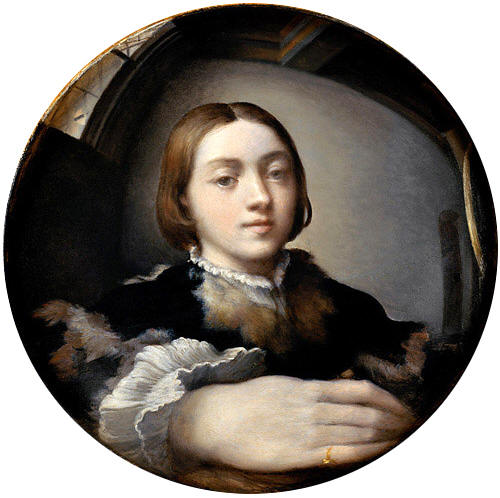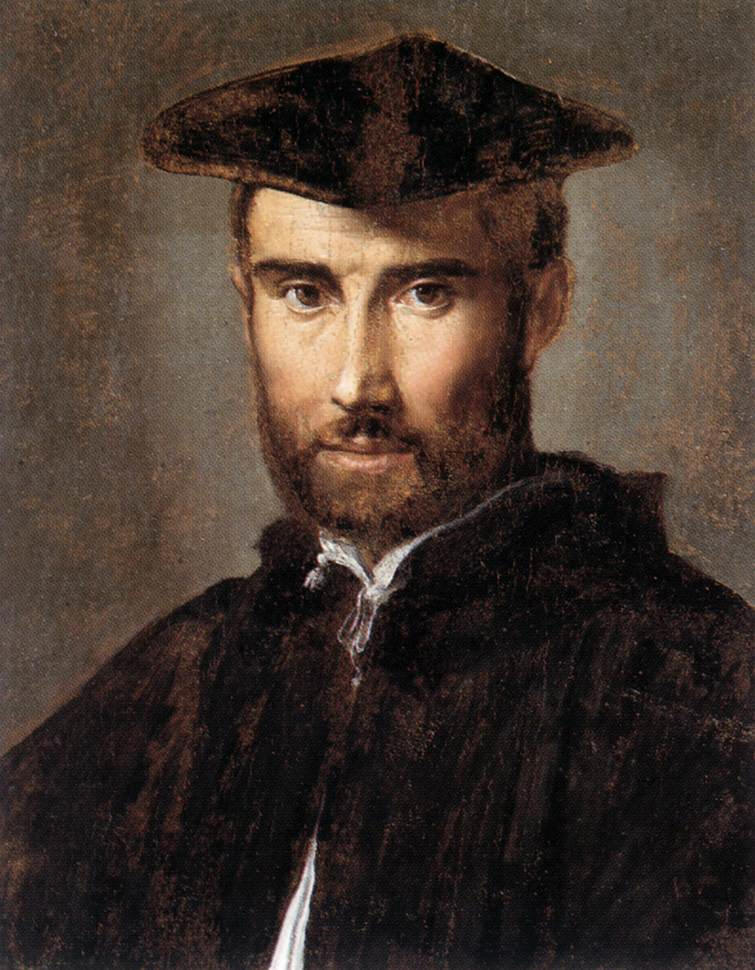|
Lecture 4 John Ashbery, Self-Portrait in a Convex Mirror (1975) |
|
Source: http://www.poets.org/poet.php/prmPID/238 Video 1 Video 2 Video 3 Video 4 Ashbery’s poem consists of 552 unrhymed lines, comprising 6 un-numbered sections. Online text.
Section Lines
I 1-99 II 100- 150 III 151-206 IV 207-250 V 251-310 VI 311-552
Links from The Academy of American Poets
John Ashbery: http://www.poets.org/poet.php/prmPID/238
Ashbery, Parmigianino, and the Convex Mirror: http://www.poets.org/viewmedia.php/prmMID/5926
Ecphrasis: Poetry Confronting Art: http://www.poets.org/viewmedia.php/prmMID/5918
The Artists & Poets of the New York School: http://www.poets.org/viewmedia.php/prmMID/5941
|
|
2 Parmigianino |
|
Girolamo Francesco Maria Mazzola, or Parmigianino Self-portrait in a Convex Mirror (c. 1523/24) (Kunsthistorisches Museum Vienna)
Segment of a wooden sphere (Diam. 24.4 cm) Image Link: http://www.wga.hu/art/p/parmigia/convex.jpg Wikipedia Link: http://en.wikipedia.org/wiki/Parmigianino
Parmigianino [Mazzola, Girolamo Francesco Maria]
(b Parma, 11 Jan 1503; d Casalmaggiore, 24 Aug 1540). Italian painter, draughtsman and printmaker. Beginning a career that was to last only two decades, he moved from precocious success in the shadow of Correggio in Parma to be hailed in the Rome of Clement VII as Raphael reborn. There he executed few large-scale works but was introduced to printmaking. After the Sack of Rome in 1527, he returned to northern Italy, where in his final decade he created some of his most markedly Mannerist works. Equally gifted as a painter of small panels and large-scale frescoes both sacred and profane, he was also one of the most penetrating portrait painters of his age. Throughout his career he was a compulsive draughtsman, not only of preparatory studies for paintings and prints, but also of scenes from everyday life and of erotica.
Source: The Grove Dictionary of Art. Link: http://www.artnet.com/library/06/0655/T065539.asp
Giorgio Vasari, Lives of the Artists :
“Then came upon him the desire to see Rome, hearing men greatly praise the works of the masters there, especially of Raffaello and Michael Angelo, and he told his desire to his old uncles. They, seeing nothing in the desire that was not praiseworthy, agreed, but said that it would be well to take something with him which would gain him an introduction to artists. And the counsel seeming good to Francesco, he painted three pictures, two small and one very large. Besides these, inquiring one day into the subtleties of art, he began to draw himself as he appeared in a barber’s convex glass. He had a ball of wood made at a turner’s and divided in half, and on this he set himself to paint all that he saw in the glass, and because the mirror enlarged everything that was near and diminished what was distant, he painted the hand a little large. Francesco himself, being of very beautiful countenance and more like an angel than a man, his portrait on the ball seemed a thing divine, and the work altogether was a happy success, having all the uster of the glass, with every reflection and the light and shade so true, that nothing more could be hoped for from the human intellect. The picture being finished and packed, together with the portrait, he set out, accompanied by one of his uncles, for Rome; and as soon as the Chancellor of the Pope had seen the pictures, he introduced the youth and his uncle to Pope Clement, who seeing the works produced and Francesco so young, was astonished, and all his court with him. And his Holiness gave him the charge of painting the Pope’s hall.” The painting was given to Pope Clement VII as a gift by the young artist. Source: http://gallery.euroweb.hu/html/p/parmigia/convex.html
|
|
3 On Parmigianino and Ashbery |
|
H. W. and Anthony Janson: http://www.people.virginia.edu/~djr4r/parmigianino.html
The artist's appearance is bland and well groomed. The features, painted with Raphael's smooth perfection, are veiled by a delicate Leonardesque sfumato. The distortions, too, are objective, not arbitrary, for the picture records what Parmigianino saw as he gazed at his reflection in a convex mirror. Why was he so fascinated by this view "through the looking glass"? Earlier painters who used the mirror as an aid to observation had "filtered out" the distortions, except when the mirror image was contrasted with a direct view of the same scene [as with Jan van Eyck's Arnolfini Portrait (1434)]. But Parmigianino substitutes his painting for the mirror itself, even employing a specially prepared convex panel. Perhaps he wanted to demonstrate that there is no single "correct" reality, that distortion is as natural as the normal appearance of things. The painting bespeaks an interest in magic as well: the convex mirror was valued in the Renaissance for its visionary effects, which seemed to reveal the future, as well as hidden aspects of the past and present.
Links: Damian J. Rollison (ed.) PAINTING WITH WORDS: An Anthology of Ekphrastic Literature:
POETRY: http://www.people.virginia.edu/~djr4r/anth_poems.html
|
|
4 Other Works by Parmigianino alluded to by Ashbery |
|
Ashbery, lines 222-25:
Later portraits such as the Uffizi ‘Gentleman,’ the Borghese ‘Young Prelate’ and The Naples ‘Antea’ issue from Mannerist Tensions… Portrait of a Man (Uffizi, Florence) (Ashbery’s ‘Gentleman’)
Source: http://cgfa.sunsite.dk/p/p-3.htm#parmigianino
‘Portrait of a Man (Rome) (‘Ashbery’s Young Prelate’)
Source: http://www.wga.hu/art/p/parmigia/port_man.jpg
Portrait of a Man with a Book (c. 1526) (Private collection)
Antea (c. 1535) (Naples)
Source: http://www.artonline.it/eng/opera.asp?IDOpera=480
LINKS
Jonathan Jones, The Guardian (January 18, 2003): http://www.guardian.co.uk/arts/portrait/story/0,11109,876906,00.html
Giorgio Vasari, Lives of the Artists: Wikipedia entry: http://en.wikipedia.org/wiki/Giorgio_Vasari
|
|
4 Parmigianino’s Style - Mannerism |
|
Mannerism,
the artistic style which gained popularity in
the period following the High Renaissance, takes
as its ideals the work of Raphael and
Michelangelo Buonarroti.
It is considered to be a period of technical
accomplishment but also of formulaic, theatrical
and overly stylized work.
Source: Artcyclopedia. Link: http://www.artcyclopedia.com/history/mannerism.html
Mannerism: Wikipedia Link: http://en.wikipedia.org/wiki/Mannerist
|
|
5 Other Paintings with Mirror Motifs |
|
Jan van Eyck's Arnolfini Portrait (1434, National Gallery, London)
Source: http://www.artchive.com/artchive/V/van_eyck/arnlfini.jpg.html
Detail (Mirror):
Source: http://www.artchive.com/artchive/v/van_eyck/eyck_arnolfini_dtl_mirror.jpg
Another image for Detail (Mirror)
Source: http://www.ibiblio.org/wm/paint/auth/eyck/arnolfini/
Another Circular Convex Image from the late Renaissance
Caravaggio, Medusa (c.1590) , Florence
Source: http://cgfa.sunsite.dk/caravagg/index.html
|
|
6 Review Questions |
|
1. How would you describe Parmigianino’s painting?
2. What would you identify as its distinctive features?
3. Compare and contrast what you find interesting about the painting with what Ashbery says about the painting? That is, what are the features he singles out?
4. What do you understand from Ashbery as his reason(s) for being interested in Parmigianino?
5. What is the significance of mirroring as a metaphor for art, in Parmigianino? And in Ashbery?
6. How does the choice of a convex mirror affect the painting? What is the significance of this choice?
7. How does Ashbery apply Parmigianino’s strategies and preoccupations to poetry and art in general?
8. In what ways does Ashbery depart from the Parmigianino painting in his poem?
9. How might you apply the mirror metaphor, and the choice of a convex mirror image, to Ashbery’s relation to Parmigianino?
10. What do you understand about the ekhphrastic relation between the pictorial and the verbal from Ashbery’s `reading’ of Parmigianino?
|
|
Last Updated 30 March 2010 |








